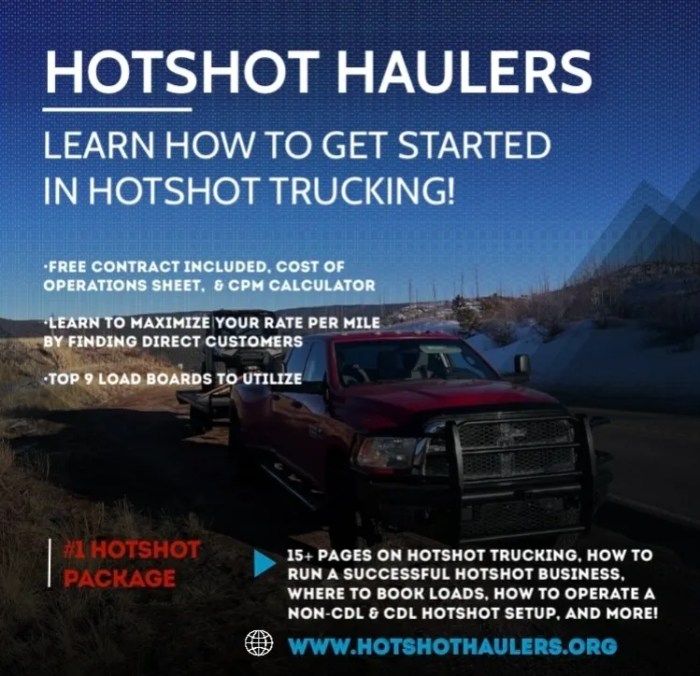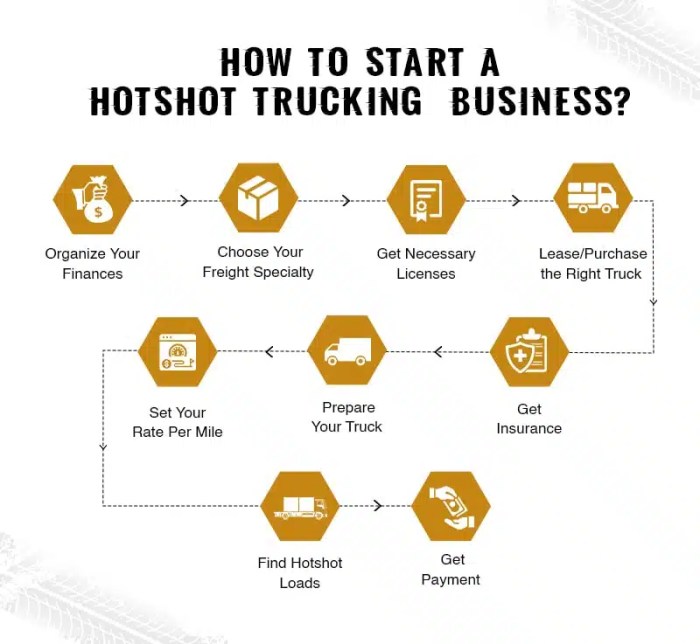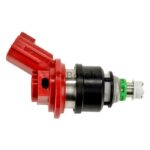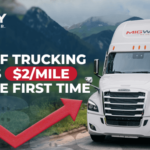How to start a hotshot trucking business? It’s a question buzzing in the minds of many aspiring entrepreneurs, drawn by the promise of independence and lucrative opportunities in the fast-paced world of logistics. This guide dives deep into the nitty-gritty, from market research and legal hurdles to securing your first client and managing your finances. Get ready to roll up your sleeves and build your own trucking empire!
Starting a hotshot trucking business isn’t just about buying a truck; it’s about building a sustainable and profitable enterprise. We’ll cover everything from crafting a rock-solid business plan and securing the necessary licenses and insurance to developing smart operational strategies, building a strong client base, and navigating the financial aspects of running your own show. This isn’t just a how-to guide; it’s your roadmap to success.
Market Research and Business Planning
Starting a hotshot trucking business requires thorough market research and a solid business plan. The industry is dynamic, influenced by factors like fuel prices, economic conditions, and the ever-changing demands of shippers. Understanding these factors is crucial for success.
Current Hotshot Trucking Market Conditions
The hotshot trucking market is experiencing fluctuating demand. While e-commerce continues to fuel growth in expedited shipping, competition is fierce. Smaller operators often compete with larger logistics companies that leverage technology and economies of scale. Regional variations exist; some areas may have higher demand due to specific industries or geographical constraints. For example, areas with significant oil and gas activity or those requiring quick delivery of time-sensitive goods (like medical supplies) often see higher demand.
Conversely, economic downturns can significantly impact demand, leading to lower freight rates and increased competition for available loads.
Business Plan and Financial Projections
A comprehensive business plan is essential. This should include an executive summary, company description, market analysis (detailed above), organization and management structure, service or product line description, marketing and sales strategy, funding request (if applicable), and financial projections. Financial projections for the first three years should be realistic and conservative. For example, a projection might show an initial year with modest revenue, increasing gradually as the business gains traction and reputation.
This would include detailed expense projections (fuel, maintenance, insurance, driver wages, etc.) and revenue projections based on estimated loads and rates. A realistic scenario might show a break-even point within the second year, followed by profitability in year three, assuming a consistent volume of business and effective cost management. Contingency planning for unexpected expenses (like major vehicle repairs) is crucial.
Target Customer Base and Value Proposition
Your target customer base will likely include businesses requiring fast and reliable delivery of smaller, time-sensitive shipments. This could encompass manufacturing companies needing urgent parts, medical facilities needing supplies, or even high-end retailers needing quick delivery of specific items. Your value proposition should emphasize your speed, reliability, and potentially specialized services. For example, you might specialize in handling fragile goods or offer 24/7 availability.
This differentiation helps you stand out from competitors. Building strong relationships with key customers through consistent, high-quality service is vital for long-term success.
SWOT Analysis
A SWOT analysis identifies your business’s Strengths, Weaknesses, Opportunities, and Threats.Strengths might include your experience in the trucking industry, your excellent driving record, or a strong network of contacts.Weaknesses could be limited initial capital, lack of brand recognition, or a small fleet of trucks.Opportunities might include the growing demand for expedited shipping, the potential to expand into new geographic areas, or the possibility of securing contracts with larger companies.Threats include intense competition, fluctuating fuel prices, economic downturns, and potential regulatory changes.
Understanding these factors allows for proactive mitigation strategies. For instance, fuel hedging strategies can help manage fuel cost volatility, and building strong relationships with shippers can help secure contracts and reduce reliance on spot market rates.
Legal and Regulatory Compliance
Starting a hotshot trucking business requires navigating a complex web of legal and regulatory hurdles. Understanding and adhering to these regulations is crucial for avoiding hefty fines, legal battles, and ultimately, business failure. This section details the essential licenses, permits, insurance, and DOT compliance procedures necessary for successful operation.
So you wanna start a hotshot trucking business? Awesome! First things first: you’ll need a serious truck, and that means picking the right hitch. Check out this guide on Best fifth-wheel hitches for Ford F-350 2025 to make sure your rig is up to the task. After you’ve sorted out the hitch, you can focus on securing your operating authority and finding your first clients.
Good luck!
Necessary Licenses and Permits
Obtaining the correct licenses and permits is the foundational step in legal hotshot trucking operations. The specific requirements vary by state and sometimes even by locality, so thorough research is essential. Generally, you’ll need a business license from your state and potentially your local municipality. This establishes your business legally. Beyond this, a crucial permit is your USDOT number, which is required for interstate commerce.
Intrastate operations might have different requirements, necessitating research into your specific state’s regulations. You might also need permits for carrying specific types of cargo, like hazardous materials. Finally, consider driver’s licenses and any endorsements needed for the types of vehicles and loads you’ll be hauling.
Insurance Requirements for Hotshot Trucking Operations
Adequate insurance is non-negotiable. The minimum requirement is usually liability insurance, covering damages or injuries caused to others. However, many businesses find it prudent to obtain additional coverage, such as cargo insurance to protect against loss or damage to the goods you’re transporting. Comprehensive insurance protects your vehicle, covering damage from accidents or other incidents. The specific coverage amounts and types will depend on factors like the value of your vehicle and the types of goods you transport.
It’s strongly advised to consult with an insurance professional specializing in trucking insurance to determine the appropriate coverage for your operation.
DOT Regulations and Compliance Procedures
The Department of Transportation (DOT) sets stringent regulations for commercial trucking operations. Compliance is paramount. This includes maintaining accurate and up-to-date logs of drivers’ hours of service (HOS) to ensure adherence to federal regulations preventing driver fatigue. Regular vehicle inspections are also mandated to ensure your trucks meet safety standards. Record-keeping is crucial; you must maintain detailed records of all inspections, maintenance, and repairs.
Failure to comply with DOT regulations can lead to significant fines and even the suspension or revocation of your operating authority. Understanding and implementing a robust compliance program is vital.
Steps for Obtaining Necessary Operating Authorities
Securing the necessary operating authorities involves a multi-step process. First, you’ll need to obtain your USDOT number by registering with the Federal Motor Carrier Safety Administration (FMCSA). This involves completing an application and providing information about your business and operations. Next, you’ll need to register with your state’s Department of Transportation (if applicable). Depending on your operations, you might also need to obtain specific permits or licenses, such as hazardous materials endorsements or interstate operating authority.
The entire process may require background checks and safety inspections. Thoroughly review all requirements and deadlines to ensure a smooth application process. Seeking assistance from a transportation consultant experienced in navigating these regulations can be invaluable.
Vehicle Acquisition and Maintenance
Starting a hotshot trucking business requires careful consideration of your vehicle. The right truck, coupled with a proactive maintenance plan, is crucial for profitability and longevity in this demanding industry. Choosing the wrong truck or neglecting maintenance can quickly lead to costly repairs and downtime.
Truck Model Selection for Hotshot Trucking
The ideal truck for hotshot trucking balances payload capacity, maneuverability, and fuel efficiency. Several models fit this description, each with its own strengths and weaknesses. Common choices include smaller, lighter-duty trucks like ¾-ton and 1-ton pickups (e.g., Ford F-350, Ram 3500, Chevrolet Silverado 3500HD) equipped with gooseneck or fifth-wheel hitches, and larger medium-duty trucks (e.g., Ford F-450, International 4000 series).
Smaller trucks are more fuel-efficient and easier to maneuver, ideal for navigating tight spaces and city driving. Larger trucks, while less fuel-efficient and harder to maneuver, can handle heavier payloads. The best choice depends heavily on the typical loads you anticipate hauling and the types of routes you’ll be traveling. For example, a contractor specializing in delivering smaller equipment to urban construction sites might favor a ¾-ton pickup, while a company hauling heavier materials to more remote locations might opt for a medium-duty truck.
Vehicle Maintenance Schedule and Cost Estimation
A comprehensive maintenance schedule is vital for preventing costly breakdowns and maximizing the lifespan of your truck. This schedule should include regular oil changes, tire rotations and inspections, brake checks, fluid flushes (coolant, transmission, etc.), and inspections of critical components like the engine, transmission, and suspension. The frequency of these services will vary based on mileage and usage, but a good rule of thumb is to follow the manufacturer’s recommended maintenance intervals.
Estimating costs requires considering factors like the truck’s make and model, the cost of parts and labor in your region, and the frequency of maintenance. For example, a basic oil change for a heavy-duty truck might cost between $150 and $300, while more extensive repairs could cost thousands of dollars. Maintaining detailed records of all maintenance performed is essential for tracking expenses and ensuring compliance with regulations.
Budgeting a percentage of your revenue for maintenance is a prudent approach, typically ranging from 5% to 15% depending on factors like truck age and usage.
Financing Options for Truck Acquisition
Securing financing for your hotshot trucking business can be achieved through several avenues. Traditional bank loans offer structured repayment plans, but often require significant collateral and a strong credit history. Equipment financing companies specialize in lending for vehicles and equipment, potentially offering more flexible terms than banks. Leasing presents another option, allowing you to use a truck without the upfront capital investment of purchasing.
However, leases typically have mileage restrictions and other limitations. Finally, small business administration (SBA) loans offer government-backed financing options with potentially lower interest rates and longer repayment periods. The optimal financing choice depends on your creditworthiness, financial resources, and business goals. For example, a well-established business with strong credit might secure favorable terms from a bank, while a new business might need to explore SBA loans or equipment financing.
Importance of Regular Vehicle Inspections and Preventative Maintenance
Regular inspections and preventative maintenance are not merely cost-saving measures; they are crucial for safety and regulatory compliance. Thorough inspections, ideally performed before and after each haul, help identify potential problems early, preventing them from escalating into costly repairs or dangerous situations. Preventative maintenance extends the life of your vehicle, reduces the likelihood of breakdowns, and minimizes downtime.
This also helps ensure compliance with Department of Transportation (DOT) regulations, which mandate regular inspections and maintenance for commercial vehicles. Failure to maintain your truck properly can result in hefty fines and operational disruptions. A proactive approach to maintenance is therefore a vital aspect of running a successful and responsible hotshot trucking business.
Operations and Logistics
Running a successful hotshot trucking business requires meticulous attention to operational efficiency. This involves more than just driving; it’s about strategic route planning, cost-effective fuel management, secure cargo handling, and a robust tracking system to ensure on-time deliveries. Let’s break down the key components.
Efficient Route and Delivery Schedule Design
Effective route planning is crucial for maximizing profitability and minimizing transit times. Software solutions like routing optimization programs can analyze various factors such as traffic patterns, road conditions, and delivery locations to generate the most efficient routes. Manually, you’ll need to consider factors like distance, speed limits, potential traffic congestion during peak hours, and any necessary stops for fuel or rest.
For example, if you regularly transport goods between two cities with heavy traffic during rush hour, scheduling deliveries for off-peak hours can significantly reduce travel time and fuel consumption. Prioritize deliveries based on urgency and deadlines, grouping shipments that share similar destinations whenever possible.
Fuel Cost Management and Fuel Efficiency Strategies
Fuel is a major expense in the trucking industry. Implementing strategies to maximize fuel efficiency is paramount to your bottom line. This involves driver training focused on fuel-efficient driving techniques, such as maintaining consistent speeds, avoiding aggressive acceleration and braking, and using cruise control on highways. Regular vehicle maintenance, including proper tire inflation and engine tune-ups, is also crucial.
Consider investing in fuel cards that offer discounts or loyalty programs. Analyzing fuel consumption data to identify areas for improvement and regularly monitoring fuel prices to optimize refueling locations are also key strategies. For example, consistently monitoring real-time fuel prices and choosing the cheapest option can save hundreds of dollars per month.
Load Planning and Cargo Securing Methods
Proper load planning and securement are critical for safety and efficiency. Overloading a truck can lead to fines, accidents, and damage to cargo. Conversely, improper securing can result in cargo shifting during transit, causing potential damage or accidents. Utilize appropriate load securing techniques, such as using straps, chains, or other tie-down systems, based on the type and weight of cargo.
Proper weight distribution is also essential to maintain vehicle stability and prevent handling difficulties. Consider using load bars or other devices to help evenly distribute weight within the trailer. Always comply with all applicable weight and dimension regulations to avoid legal issues and ensure safe transportation.
Shipment Tracking and Delivery Management System
Implementing a reliable shipment tracking system is vital for maintaining transparency with clients and managing deliveries efficiently. This could involve using GPS tracking devices installed in your vehicles, providing real-time location updates and estimated times of arrival (ETAs). Integrating this data with a delivery management software can further streamline operations, allowing you to track shipments from pickup to delivery, manage driver schedules, and generate reports on key performance indicators (KPIs).
This system allows for proactive communication with clients regarding potential delays and efficient management of any unexpected issues. For example, a system that automatically alerts clients of delays caused by unforeseen circumstances like traffic accidents, provides a level of professionalism and transparency that builds customer trust.
Handling Delivery Delays or Issues
Delays and unexpected issues are inevitable in the trucking business. Having a clear procedure in place to handle these situations is crucial for minimizing disruption and maintaining customer satisfaction. This involves proactively communicating with clients as soon as a delay is anticipated, providing updates on the situation, and offering alternative solutions whenever possible. Document all delays and issues thoroughly, including the cause, actions taken, and resolution.
A well-defined protocol helps ensure consistent responses to various challenges, maintaining professionalism and minimizing potential conflicts. For example, having a pre-written email template to inform clients about delays due to unforeseen circumstances saves time and maintains a consistent communication style.
Finding and Managing Customers: How To Start A Hotshot Trucking Business

Landing your first few hotshot trucking clients is crucial for getting your business off the ground. A well-defined marketing strategy, coupled with excellent customer service, will be the key to building a sustainable and profitable operation. This section Artikels effective strategies for attracting clients, nurturing relationships, and negotiating favorable rates.
Marketing Strategies to Attract Clients
Building a strong client base requires a multi-pronged approach. Simply having a great service isn’t enough; you need to actively market your business to potential shippers. This involves leveraging both online and offline channels to reach your target audience. Consider the unique aspects of hotshot trucking—speed, reliability, and specialized handling—when crafting your marketing message. Highlighting these benefits will differentiate you from larger, less agile carriers.
Building Strong Relationships with Shippers
Strong relationships are the backbone of any successful hotshot trucking business. Building trust and reliability with shippers is paramount. Consistent, on-time delivery, clear communication, and proactive problem-solving are essential for fostering long-term partnerships. Regular check-ins, even after a successful delivery, demonstrate your commitment to their business and build rapport. Consider personalized communication tailored to each client’s specific needs and preferences.
For example, some clients might prefer email updates, while others might prefer phone calls.
Negotiating Rates and Contracts
Negotiating rates requires a delicate balance between securing profitable margins and maintaining competitive pricing. Thoroughly research market rates for similar services in your area to establish a baseline. Factor in your operating costs, including fuel, maintenance, insurance, and driver wages, to determine a profitable minimum rate. Be prepared to justify your pricing based on the value you offer—speed, reliability, and specialized handling.
Consider offering different pricing structures based on volume or contract length. Always have a written contract outlining the terms of service, payment schedule, and liability to protect both you and your client.
Customer Service and Maintaining Client Relationships, How to start a hotshot trucking business
Exceptional customer service is crucial for retention and referrals. Responsiveness, clear communication, and problem-solving skills are key. Address any concerns or issues promptly and professionally. Gather feedback regularly to improve your services. A simple thank-you note after a delivery or a follow-up call to check on satisfaction can go a long way in building loyalty.
Consider implementing a customer relationship management (CRM) system to track interactions and maintain organized client records.
Marketing Channel Comparison
Effective marketing requires a balanced approach. Here’s a comparison of different channels:
| Marketing Channel | Pros | Cons | Cost |
|---|---|---|---|
| Online Platforms (Load Boards, Trucking Websites) | Wide reach, targeted advertising options | Competition can be fierce, requires consistent monitoring | Variable, depending on platform and advertising spend |
| Networking (Industry Events, Trucking Associations) | Builds personal connections, fosters trust | Can be time-consuming, requires travel | Variable, depending on event fees and travel expenses |
| Direct Sales (Cold Calling, Email Marketing) | Direct communication, personalized approach | Can be time-consuming, high rejection rate | Relatively low, primarily time investment |
| Referrals (Existing Clients) | High conversion rate, builds trust | Relies on client satisfaction | Low, primarily focused on maintaining client relationships |
Financial Management

Running a successful hotshot trucking business requires more than just driving skills; it demands shrewd financial management. Ignoring the financial side can quickly lead to insolvency, even with a steady stream of clients. This section Artikels key financial strategies to ensure your business thrives.
Income and Expense Tracking
A robust system for tracking income and expenses is the cornerstone of sound financial management. This involves meticulously recording every transaction, whether it’s fuel costs, maintenance repairs, driver salaries, or payments received from clients. Several methods exist, from simple spreadsheets to sophisticated accounting software. Spreadsheets offer a basic, cost-effective solution, particularly for smaller operations. However, as the business grows, dedicated accounting software provides better organization, reporting capabilities, and integration with other business tools.
For example, QuickBooks or Xero offer features specifically designed for small businesses, enabling the generation of profit and loss statements, balance sheets, and cash flow projections. Regardless of the method chosen, consistency is key. Regularly updating the records ensures an accurate financial picture at all times.
Cash Flow Management and Profitability
Managing cash flow effectively is crucial for survival. Hotshot trucking often involves fluctuating income due to varying delivery schedules and client payment terms. To mitigate this, develop strategies for predicting cash inflows and outflows. This might involve analyzing historical data to identify peak and slow seasons, negotiating favorable payment terms with clients (e.g., shorter payment cycles), and establishing a line of credit to cover short-term cash shortfalls.
Maintaining a healthy cash reserve is also vital, acting as a buffer against unexpected expenses like vehicle repairs or seasonal slowdowns. Profitability hinges on efficient cost management and competitive pricing. Regularly reviewing expenses and identifying areas for cost reduction—fuel efficiency measures, negotiating better rates with suppliers—is crucial. Analyzing pricing strategies to ensure they cover all costs and generate a reasonable profit margin is also essential.
For example, a trucking business might use software to analyze fuel costs and delivery distances to optimize routes and minimize expenses.
Financing for Business Expansion
As your business grows, you may need financing for expansion—purchasing additional trucks, hiring more drivers, or investing in new technology. Several options exist. Small business loans from banks or credit unions are a common choice, often requiring a solid business plan and good credit history. Alternatively, you could explore equipment financing, which allows you to finance the purchase of trucks or trailers specifically.
Government-backed loan programs, such as those offered by the Small Business Administration (SBA), may also be available, offering more favorable terms than conventional loans. Finally, seeking investment from angel investors or venture capitalists is an option for significant expansion, but usually involves relinquishing some ownership equity. The best option depends on your specific needs and financial situation.
For example, a business might start with a small business loan to buy one additional truck and then explore equipment financing for subsequent purchases as revenue increases.
Budgeting and Operating Costs
A comprehensive budget is a roadmap for your business’s financial health. It should encompass all operating costs, including fuel, maintenance, insurance, driver salaries, permits and licenses, administrative expenses, and loan repayments. Regularly comparing actual expenses against the budgeted amounts helps identify discrepancies and allows for timely adjustments. Developing a realistic budget requires thorough research and accurate forecasting.
For example, a budget might allocate a specific percentage of revenue for fuel based on historical data and projected mileage. By accurately predicting expenses, you can effectively manage your resources and avoid unexpected financial shortfalls. Regularly reviewing and updating the budget is crucial to ensure it reflects the changing dynamics of the business.
Risk Management and Safety
Hotshot trucking, while offering lucrative opportunities, presents unique safety and risk challenges. The high-value, time-sensitive nature of the cargo, coupled with the often-demanding driving conditions and tight deadlines, necessitates a robust risk management and safety program. Failing to adequately address these risks can lead to significant financial losses, legal repercussions, and reputational damage.Potential risks in hotshot trucking are multifaceted and demand proactive mitigation strategies.
A comprehensive safety plan is crucial for ensuring both the driver’s well-being and the safe delivery of the goods. This section details the key risks, Artikels a proactive safety plan, and discusses procedures for handling incidents and accidents.
Potential Risks Associated with Hotshot Trucking
The inherent risks in hotshot trucking stem from a combination of factors, including the nature of the cargo, the driving environment, and operational complexities. These risks can be broadly categorized into operational, financial, and legal risks. Operational risks encompass those related to vehicle accidents, cargo damage or loss, driver fatigue, and inclement weather. Financial risks include cargo theft, insurance claims, and equipment failures.
Legal risks involve regulatory non-compliance, liability for accidents, and contract disputes. Understanding these interconnected risks is the first step towards effective risk mitigation.
So you wanna start a hotshot trucking business? Awesome! First things first, you’ll need a reliable truck, and finding one on a budget can be tricky. Check out this list of Most reliable used trucks under $20k 2025 to get some ideas. Once you’ve got your ride sorted, focus on getting your licensing and insurance in order – that’s the real legwork to getting your business off the ground.
Safety Plan to Mitigate Risks
A comprehensive safety plan should address all identified risks. This plan should include driver qualification and training, vehicle maintenance protocols, route planning considerations, and emergency procedures. Regular vehicle inspections are paramount, focusing on brakes, tires, and other critical components. Pre-trip inspections should be meticulously documented. Driver training should emphasize defensive driving techniques, load securement procedures, and the importance of complying with all traffic laws.
The company should invest in advanced driver-assistance systems (ADAS) to enhance safety. For example, features like lane departure warnings and automatic emergency braking can significantly reduce the likelihood of accidents. Furthermore, a robust communication system should be in place to allow for real-time updates on the driver’s location and status.
Accident and Incident Handling Procedures
In the event of an accident or incident, immediate action is crucial. The company should have a clearly defined protocol that includes steps such as contacting emergency services, securing the scene, documenting the incident thoroughly (including photographs and witness statements), and notifying insurance providers. Following established procedures ensures compliance with legal requirements and protects the company’s interests. This includes understanding and complying with relevant reporting requirements to the Department of Transportation (DOT).
A detailed accident report should be completed and retained as part of the company’s records. Internal investigations may be conducted to identify contributing factors and implement corrective actions.
Driver Training and Safety Protocols
Driver training is not a one-time event; it should be an ongoing process. Regular refresher courses covering defensive driving, load securement, and emergency procedures are essential. The company should establish clear safety protocols that all drivers must adhere to. These protocols should cover aspects such as hours of service compliance, pre- and post-trip inspections, and communication procedures.
Background checks and drug testing should be mandatory for all drivers. Furthermore, drivers should be equipped with appropriate safety gear, such as high-visibility vests and personal protective equipment (PPE). Regular safety meetings should be conducted to reinforce safety protocols and address any concerns raised by drivers. The company should also foster a strong safety culture where reporting near misses and safety concerns is encouraged without fear of retribution.
Technology and Tools
In today’s competitive hotshot trucking market, leveraging technology is no longer optional; it’s essential for efficiency, profitability, and staying ahead of the curve. The right tools can streamline operations, improve customer service, and ultimately, boost your bottom line. This section will explore the key technologies and software solutions that can significantly benefit your hotshot trucking business.
Trucking Management Software Benefits
Trucking management software offers a centralized platform to manage various aspects of your business. These systems typically handle dispatching, route optimization, driver communication, billing, and accounting, all in one place. This consolidated approach eliminates the need for multiple disparate systems, saving time and reducing the risk of errors. The benefits extend to improved operational efficiency, better tracking of shipments, and enhanced financial control, leading to increased profitability and better decision-making.
For example, software can automatically calculate fuel costs based on mileage and current prices, providing a more accurate picture of your operating expenses.
GPS Tracking and Navigation System Usage
GPS tracking and navigation systems are crucial for real-time monitoring of your shipments and drivers. These systems provide accurate location data, allowing you to track deliveries, identify potential delays, and optimize routes for fuel efficiency. Features such as geofencing can alert you if a vehicle enters or leaves a designated area, enhancing security and accountability. Furthermore, advanced navigation systems consider real-time traffic conditions, suggesting the most efficient routes, minimizing delivery times and fuel consumption.
This leads to improved on-time delivery rates and reduced operational costs. For instance, a driver might encounter unexpected road closures; the GPS system would immediately reroute them, preventing significant delays.
Communication Technology’s Role in Efficient Operations
Effective communication is the backbone of any successful trucking operation. Real-time communication tools, such as mobile apps and two-way radios, allow for seamless interaction between dispatchers, drivers, and clients. Instant updates on shipment status, delivery times, and potential issues ensure transparency and proactive problem-solving. This rapid exchange of information minimizes delays, improves customer satisfaction, and enhances overall operational efficiency.
For example, if a driver encounters a mechanical issue, they can immediately inform dispatch, allowing for swift arrangements for repairs or alternative transportation.
Examples of Helpful Apps and Software
Several apps and software solutions are specifically designed to support hotshot trucking businesses. Examples include transportation management systems (TMS) like Samsara or KeepTruckin, which offer features like GPS tracking, driver behavior monitoring, and electronic logging devices (ELD) compliance. Other helpful tools include route planning apps like Rand McNally or Google Maps, and communication platforms like WhatsApp or dedicated trucking dispatch software.
Furthermore, accounting software tailored for small businesses can streamline financial management. Choosing the right combination of tools will depend on the specific needs and scale of your operation, but investing in technology is a strategic move for growth and success in this demanding industry.
Building a Strong Team (if applicable)
A successful hotshot trucking business relies heavily on a skilled and reliable team. Finding, training, and retaining quality drivers is crucial for profitability and long-term success. A well-managed team contributes directly to on-time deliveries, customer satisfaction, and a positive company reputation.
Qualities of a Good Hotshot Truck Driver
A top-tier hotshot driver possesses a unique blend of skills and personality traits. They need to be more than just competent behind the wheel; they must be adept at navigating complex logistics, communicating effectively, and maintaining a professional demeanor. These drivers are the face of your company, interacting directly with clients and representing your business’s values.
- Exceptional Driving Skills: Proficiency in operating various types of trailers, navigating challenging routes, and adhering to strict safety regulations is paramount. Experience with specialized cargo handling is a plus.
- Strong Communication Skills: Effective communication with dispatchers, customers, and other stakeholders is essential for smooth operations. This includes clear and concise reporting, proactive problem-solving, and professional interaction.
- Time Management and Organizational Skills: Hotshot trucking demands precision and efficiency. Drivers need to manage their time effectively, plan routes efficiently, and maintain accurate records.
- Problem-Solving Abilities: Unexpected delays and logistical challenges are inevitable. Drivers must be able to think on their feet, find creative solutions, and make sound judgments under pressure.
- Customer Service Orientation: Treating clients with respect and professionalism is crucial for building strong relationships and securing repeat business. Drivers should be friendly, helpful, and willing to go the extra mile to ensure customer satisfaction.
Hiring and Training Drivers
The hiring process should be thorough and focused on identifying candidates who possess the necessary skills and qualifications. Background checks, driving record reviews, and skills assessments are essential steps. Training should cover both practical driving skills and operational procedures.
- Application and Screening: Review applications carefully, focusing on experience, qualifications, and references. Conduct thorough background checks and verify driving records.
- Skills Assessment: Assess driving skills through practical tests, evaluating their ability to handle different types of trailers and navigate various driving conditions. Assess communication and problem-solving skills through interviews and scenarios.
- Onboarding and Training: Provide comprehensive training on company policies, safety procedures, operational protocols, and the use of relevant technology and software. This could include classroom instruction, on-the-job training, and mentorship programs.
- Ongoing Professional Development: Encourage ongoing professional development through continuing education courses, workshops, and participation in industry events to maintain up-to-date knowledge and best practices.
Motivating and Retaining Employees
Employee retention is crucial for maintaining consistency and efficiency. Offering competitive compensation, benefits, and opportunities for advancement are key to keeping your drivers happy and engaged.
- Competitive Compensation and Benefits: Offer a competitive salary, health insurance, paid time off, and other benefits to attract and retain top talent.
- Opportunities for Advancement: Provide opportunities for career growth, such as promotions to lead driver roles or management positions.
- Recognition and Rewards: Recognize and reward exceptional performance through bonuses, awards, and public acknowledgement. This could include a driver-of-the-month program or a yearly award ceremony.
- Open Communication and Feedback: Foster open communication between management and drivers. Regular feedback sessions allow drivers to voice concerns and provide input on company operations.
Fostering a Positive Work Environment
A positive work environment is essential for employee morale and productivity. This involves creating a culture of respect, trust, and open communication.
A supportive and collaborative atmosphere improves teamwork, reduces stress, and enhances overall job satisfaction. Regular team meetings, company outings, and opportunities for social interaction can significantly contribute to building a strong team spirit. Clear communication channels, fair policies, and a commitment to safety also create a more positive work experience.
Wrap-Up
Launching your own hotshot trucking business is a challenging but potentially incredibly rewarding venture. By carefully considering the market, complying with regulations, building strong client relationships, and implementing efficient operational strategies, you can significantly increase your chances of success. Remember, thorough planning, smart decision-making, and a dedication to safety and customer satisfaction are key to navigating the complexities of this exciting industry.
Now get out there and make it happen!









